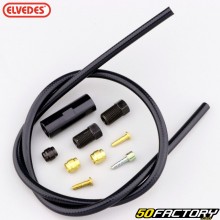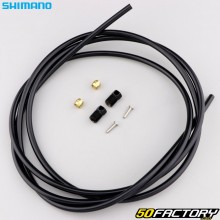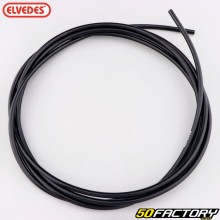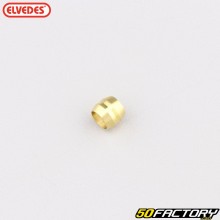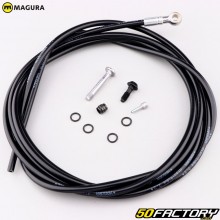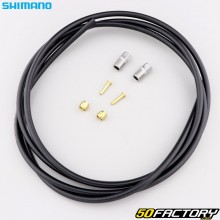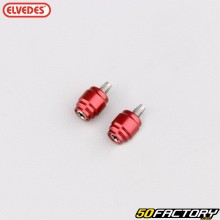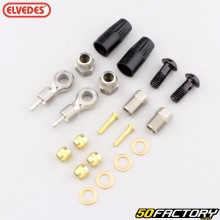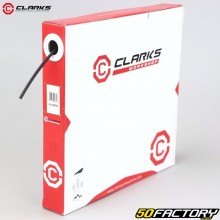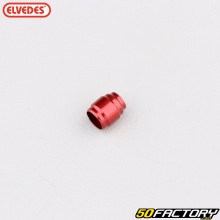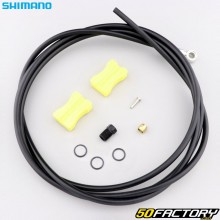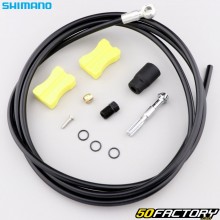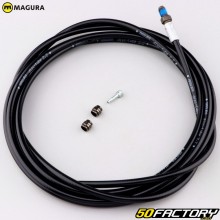 Front brake hose
Front brake hose
-
- IN STOCK18€00
- IN STOCK30€40
- IN STOCK22€90
-
- IN STOCK0€60
-
-
- IN STOCK34€90
-
- IN STOCK31€40
- IN STOCK99€90
- STOCK EXHAUSTED21€60
- IN STOCK1€70
- IN STOCK38€00
- IN STOCK36€00
-
-
-
- IN STOCK150€80
-
-
- IN STOCK33€20
Introduction to ATV Front Brake Hose
Ensuring good braking performance is crucial for safety and comfort when riding a mountain bike. This is where the front brake hose comes into play. An essential component, it plays a major role in your bike's braking system. To fully understand the importance of this component, you need to look at how it works and how it contributes to the overall braking mechanism. Indeed, the front brake hose is more than just a pipe. It is the vital link between the brake lever you operate and the force braking force that is applied to the wheel. This is especially important in emergency situations where a quick reaction is required.
What is it ?
The front brake hose is a flexible conduit that allows the transfer of brake fluid from the master cylinder to the brake calipers. It is usually made of reinforced rubber or braided stainless steel to withstand pressure and extreme operating conditions. This part is essential for efficient and responsive braking, essential for tackling rough terrain safely. Choosing the right type of hose is therefore crucial to ensuring the optimal performance of your braking system.
Why is it important?
The front brake hose plays a key role in ensuring efficient transmission of power. force brake system. Without a quality hose, the brake fluid may not reach the calipers with the necessary pressure, compromising the braking ability of your bike. A well-maintained and high-quality hose ensures a quick and precise response from the braking system, contributing to your safety on the trails. It is therefore a key element of your mountain bike equipment that should not be overlooked.
The different types
There are two main types of mountain bike front brake lines: rubber and stainless steel. Each of these types offers distinct characteristics that make them better suited to certain situations than others. Choosing between these two types largely depends on your riding style, the terrain you ride on, and your budget.
Rubber models
Rubber hoses are commonly used due to their flexibility and relatively low cost. They are typically made of reinforced rubber to withstand the pressure of the brake fluid. However, they can expand under pressure, which can cause a spongy feeling in the brake lever and a decrease in braking efficiency. Their ease of installation and adaptability make them a popular choice for casual or beginner riders.
Stainless steel models
Braided stainless steel hoses, often referred to as aviation hoses, offer superior resistance to pressure and heat. By preventing swelling under pressure, they ensure constant pressure, which translates into par more precise and powerful braking. These hoses are often chosen forar cyclists who demand braking performance, although they require more rigorous maintenance. For those looking to optimize their braking system for extreme conditions, these hoses are a wise investment.
How to choose the right type
Choosing the right front brake hose for your mountain bike will depend on several factors, including the type of bike you own and your specific braking needs. It is essential to consider how you use your mountain bike in order to make the most appropriate choice.
Depending on your bike
It is important to choose a hose that is compatible with the make and model of your mountain bike. Check the specifications of your bike and consult the manufacturer's recommendations. At our company, we offer a variety of hoses that are compatible with a wide range of mountain bikes to meet all your needs. It is essential to ensure that the hose chosen matches the technical specifications of your mountain bike to ensure optimal braking performance.
Depending on your braking needs
If you use your mountain bike mainly for city riding or on easy terrain, a rubber hose may be sufficient. On the other hand, if you ride your mountain bike intensively or on difficult terrain, a stainless steel hose would be more appropriate to ensure optimal braking performance. It is important to note that stainless steel hoses offer better resistance to heat and pressure, making them more suitable for extreme riding conditions.
Installation
Installing a front brake line on a mountain bike, while it may seem complicated, is actually a fairly simple process if you follow the right steps. With a few basic tools and a little patience, you can do it yourself, saving yourself the expense of hiring a professional. This task will also give you a better understanding of how your bike works and will help you identify and fix future problems.
Preparation for installation
Before you begin, make sure you have all the necessary tools, including an Allen wrench, hose clamps, and a brake bleeder kit. It's also recommended to work in a clean, well-lit area to avoid losing small parts. Take the time to familiarize yourself with the different parts of your brake system and understand how they work together.
Installation steps
1. Remove the old hose by unscrewing the fittings at the master cylinder and brake calipers.
2. Install the new hose, making sure to tighten the fittings securely to prevent any brake fluid leaks.
3. Bleed the brake system to remove air bubbles and ensure constant pressure.
4. Test the brakes to make sure everything is working properly before driving again.
Tips for a successful installation
During installation, be patient and don't rush. Always make sure that the fittings are tight and the system is properly bled before testing the brakes. If in doubt, do not hesitate to consult a professional or refer to online guides.
Care instructions
To ensure optimal braking performance and extend the life of your mountain bike, it is essential to regularly check the condition of your front brake hose and replace it if necessary. Proper maintenance can help you avoid unexpected braking problems on the trail and maintain the health of your braking system in general.
When and how to check the status?
It is recommended that you check the condition of the hose every six months or after heavy use, such as after riding over particularly rough terrain. Look for signs of cracking, kinking, or leaks. If you notice any of these signs, or if the brakes become less responsive, it is time to replace the hose.
Replacement procedure
Replacing a front brake hose follows the same steps as the initial installation. Be sure to bleed the system after replacement to remove any air bubbles and ensure effective braking. Don't forget to test your brakes after replacement to ensure they are working properly.
Additional care tips
In addition to checking your hose, remember to check your brake fluid level regularly and replace it if necessary. Clean brake fluid and the right amount also contribute to effective braking.
Products available from our company
At the heart of our mission at our company is a commitment to providing a wide range of high-quality ATV front brake lines designed to meet all your braking needs. We carefully select our products for their superior quality, impeccable performance and proven durability.
Presentation of our products
Our range of front brake hoses for mountain bikes stands out for itsar its diversity, including models in reinforced rubber and stainless steel. We also offer complete kits for hassle-free and quick installation, as well as essential accessories for maintaining your braking system. In addition, our selection extends to options suitable for all budgets, without compromising on quality.
Our commitment to you
In addition to offering you quality products, our company is committed to supporting you in your choice. Our experts are at your disposal to advise you and answer your questions, in order to help you choose the product best suited to your needs.








